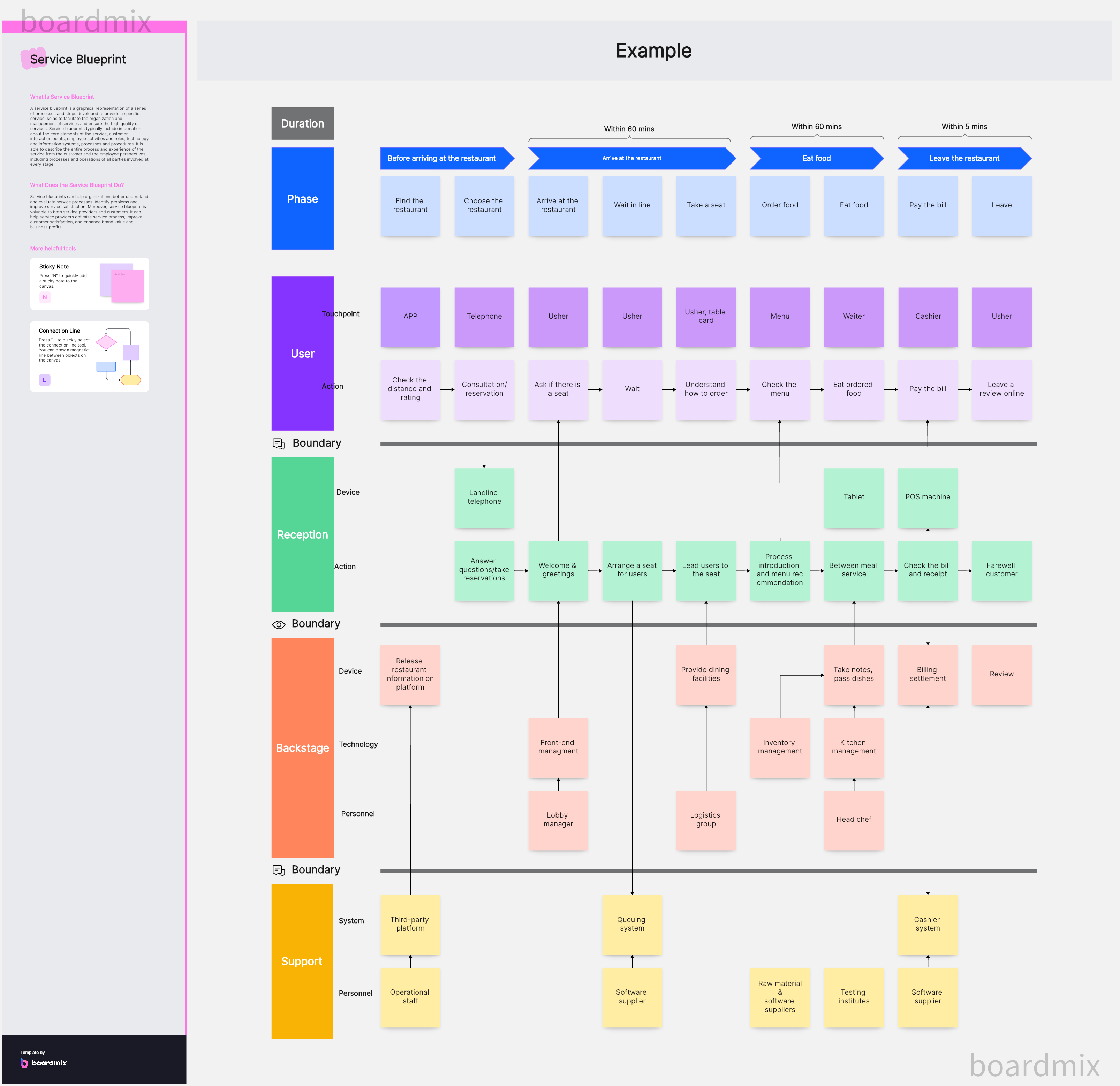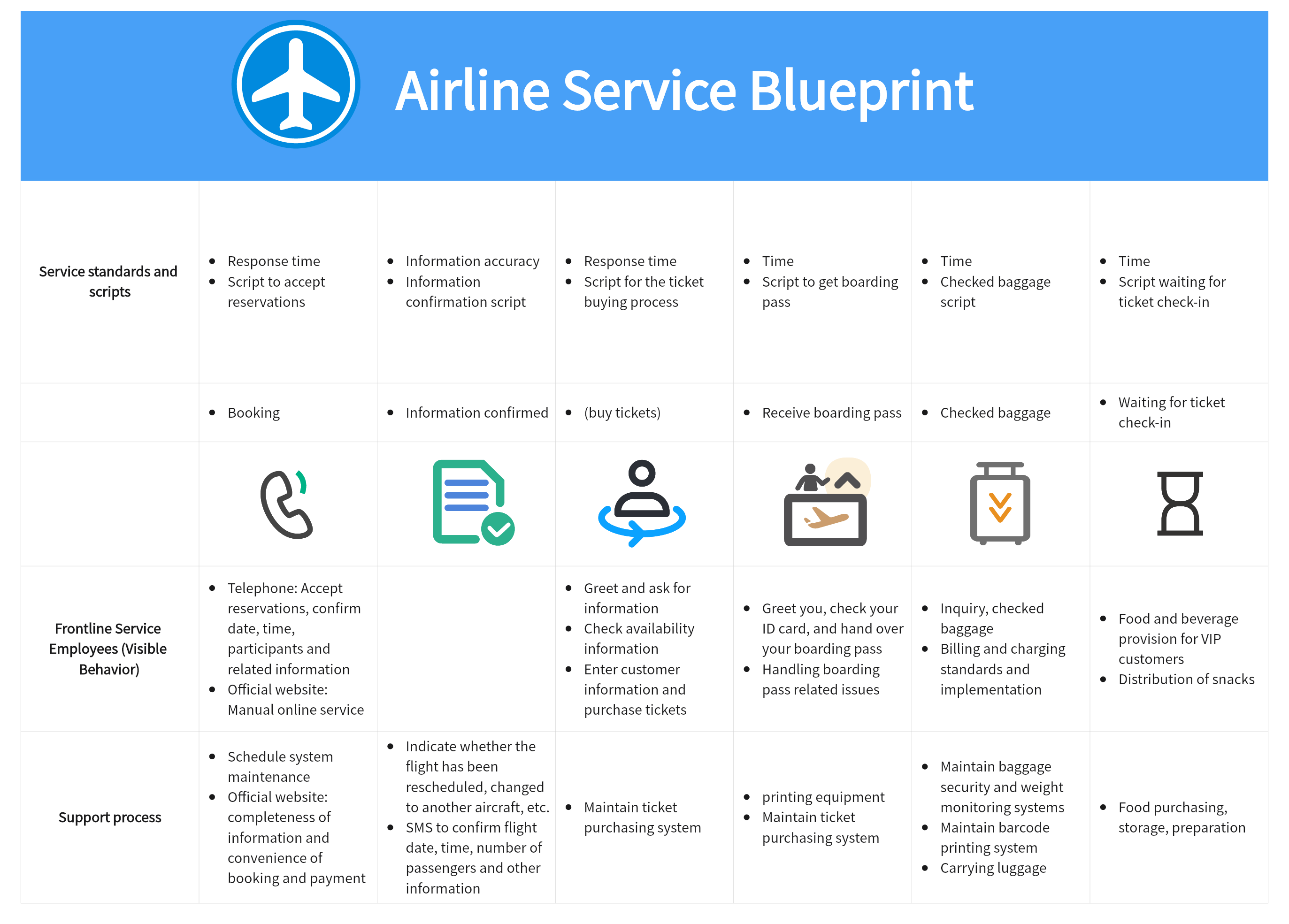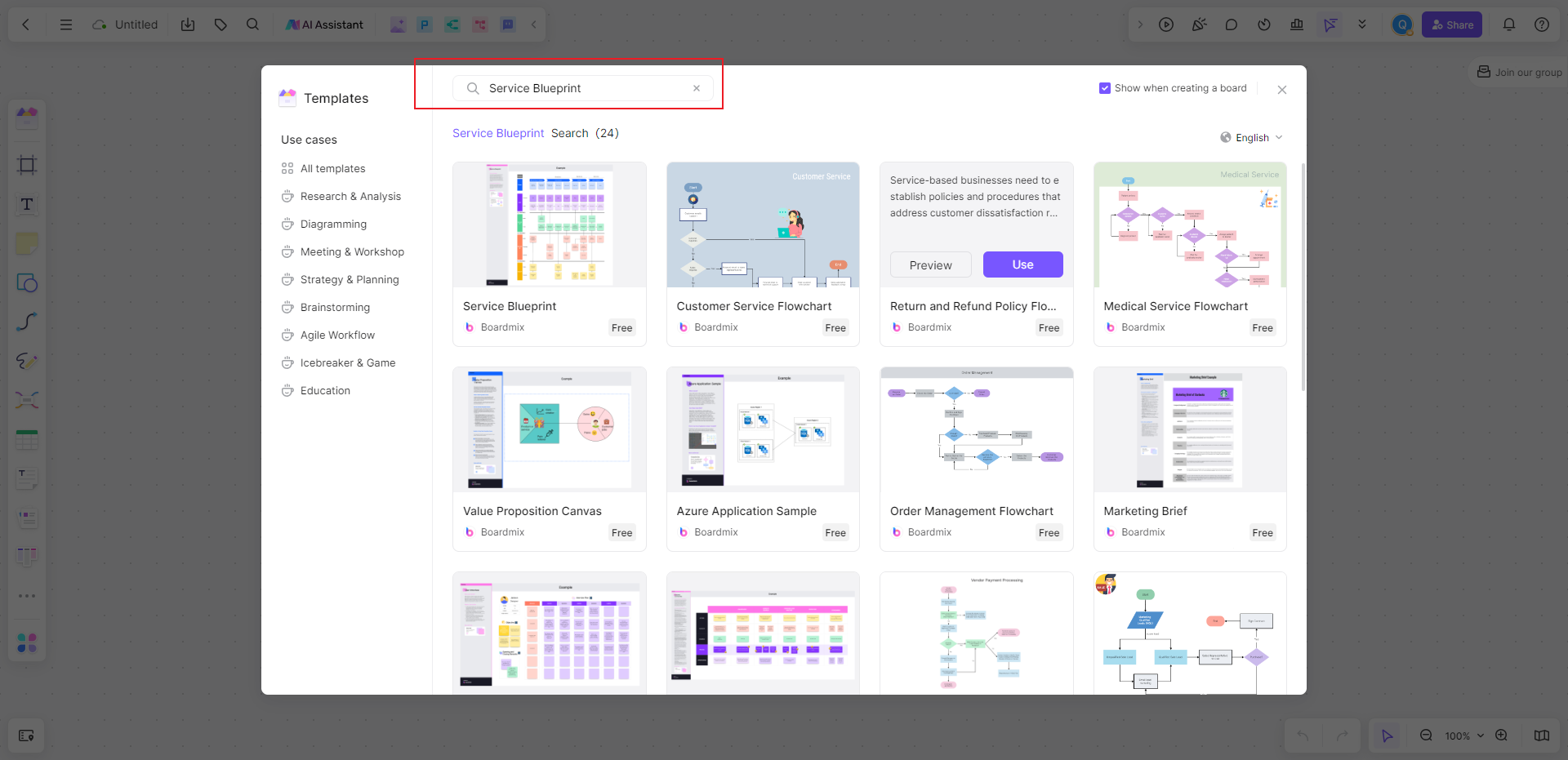Service blueprinting is a valuable tool for businesses to map out and improve their service processes. By visualizing the customer journey and identifying pain points, companies can enhance their service delivery and customer experience. This powerful tool enables you to visualize every interaction, identify potential bottlenecks, and streamline your operations for optimal efficiency. But how does one create a service blueprint? And what does a practical example look like? Let's demystify this concept together. In this journey, we will explore real-world examples and easy-to-use templates to help you create your Service Blueprint.

Restaurant Service Blueprint Example
The restaurant service blueprint template is a visual representation of the service delivery process in a restaurant, outlining the various touchpoints, interactions, and systems involved in providing a dining experience to customers. It helps restaurant owners and managers understand and analyze the customer journey, identify pain points, and design better service experiences.
- Customer Journey: This section maps out the steps and stages of the customer's dining experience, from making a reservation to leaving the restaurant. It includes touchpoints like greeting, seating, ordering, serving, and payment.
- Frontstage Actions: These are the visible actions taken by restaurant staff and customers during the dining experience. It includes interactions like taking orders, serving food and drinks, clearing tables, and providing recommendations.
- Backstage Actions: These are the behind-the-scenes activities that support the frontstage actions. It includes activities like food preparation, cooking, dishwashing, inventory management, and restocking.
- Support Processes: This section outlines the processes and systems that enable the smooth operation of the restaurant. It includes reservation management systems, POS (Point of Sale) systems, inventory tracking systems, and communication tools.
- Physical Evidence: This component includes tangible elements that shape the customer experience in the restaurant. It includes the restaurant's ambiance, decor, table settings, menu design, signage, and lighting.
- Customer Actions: These are the actions taken by customers during their dining experience. It includes actions like ordering food and drinks, requesting assistance, providing feedback, and making payments.
- Employee Actions: This section outlines the actions and behaviors expected from restaurant staff during the service delivery process. It includes interactions with customers, adherence to service standards, teamwork, and problem-solving.
By using the restaurant service blueprint template format, restaurant owners and managers can gain a comprehensive understanding of the service process and identify areas for improvement or innovation. It also helps align different departments and staff members in delivering a consistent and exceptional dining experience to customers.
Hotel Service Blueprint Example
The hotel service blueprint is a visual representation of the service delivery process in a hotel, outlining the various touchpoints, interactions, and systems involved in providing a satisfactory experience to guests. It helps hotel owners and managers understand and analyze the guest journey, identify pain points, and design better service experiences. There are typical components for hotel service blueprints.
- Guest Journey: This section maps out the steps and stages of the guest's experience, from check-in to check-out. It includes touchpoints like reception, room service, housekeeping, dining, and concierge services.
- Frontstage Actions: These are the visible actions taken by hotel staff and guests during their stay. It includes interactions like check-in, room assignment, luggage handling, room cleaning, and assistance with amenities.
- Backstage Actions: These are the behind-the-scenes activities that support the frontstage actions. It includes activities like reservation management, inventory control, maintenance, security, and staffing.
- Support Processes: This section outlines the processes and systems that enable the smooth operation of the hotel. It includes reservation management systems, property management systems (PMS), billing systems, key card access systems, and communication tools.
- Physical Evidence: This component includes tangible elements that shape the guest experience in the hotel. It includes the hotel's lobby design, room decor, amenities, signage, lighting, and overall ambiance.
- Guest Actions: These are the actions taken by guests during their stay. It includes actions like requesting services, using hotel facilities, giving feedback, and making payments.
- Employee Actions: This section outlines the actions and behaviors expected from hotel staff during the service delivery process. It includes interactions with guests, adherence to service standards, teamwork, problem-solving, and handling guest complaints.
By using the hotel service blueprint template format, hotel owners and managers can gain a comprehensive understanding of the service process and identify areas for improvement or innovation. It also helps align different departments and staff members in delivering a consistent and exceptional guest experience.
UX Service Blueprint Example
The UX service blueprint is a visual representation of the user experience design process, outlining the various touchpoints, interactions, and systems involved in providing a satisfactory user experience. It helps UX designers and researchers understand and analyze the user journey, identify pain points, and design better user experiences. While there is no one-size-fits-all format for UX service blueprints, they typically include the following components:
- User Journey: This section maps out the steps and stages of the user's experience, from initial discovery to final interaction. It includes touchpoints like website navigation, product features, onboarding process, and customer support.
- Frontstage Actions: These are the visible actions taken by users and designers during the user experience. It includes interactions like signing up, browsing content, completing tasks, and providing feedback.
- Backstage Actions: These are the behind-the-scenes activities that support the frontstage actions. It includes activities like user research, wireframing, prototyping, usability testing, and data analysis.
- Support Processes: This section outlines the processes and tools that enable the smooth operation of the UX design process. It includes collaboration tools, design software, project management systems, and communication channels.
- Physical Evidence: This component includes tangible elements that shape the user experience. It includes the design of interfaces, visual aesthetics, typography, color schemes, and overall branding.
- User Actions: These are the actions taken by users during their interaction with the product or service. It includes actions like searching for information, making selections, completing forms, and sharing content.
- Designer Actions: This section outlines the actions and behaviors expected from UX designers during the design process. It includes conducting user research, creating wireframes and prototypes, iterating designs based on feedback, and collaborating with stakeholders.
By using the UX service blueprint template format, UX designers and researchers can gain a comprehensive understanding of the user experience process and identify areas for improvement or innovation. It also helps align different team members in delivering a consistent and exceptional user experience.
Coffee Shop Service Blueprint Example
The coffee shop service blueprint is a visual representation of the customer journey and the various touchpoints and processes involved in providing a satisfactory coffee shop experience. It helps coffee shop owners and employees understand and analyze the customer journey, identify pain points, and design better customer experiences.

- Customer Journey: This section maps out the steps and stages of the customer's experience, from entering the coffee shop to leaving. It includes touchpoints like ordering at the counter, waiting for the drink, interacting with baristas, and enjoying the beverage.
- Frontstage Actions: These are the visible actions taken by customers and employees during the coffee shop experience. It includes interactions like placing orders, paying, brewing coffee, serving food, and engaging in friendly conversations.
- Backstage Actions: These are the behind-the-scenes activities that support the frontstage actions. It includes activities like coffee bean sourcing, inventory management, equipment maintenance, staff training, and quality control.
- Support Processes: This section outlines the processes and tools that enable the smooth operation of the coffee shop. It includes cash register systems, order management software, brewing equipment, inventory tracking systems, and communication channels.
- Physical Evidence: This component includes tangible elements that shape the coffee shop experience. It includes the interior design, layout, furniture, signage, lighting, menu boards, and overall ambiance.
- Customer Actions: These are the actions taken by customers during their visit to the coffee shop. It includes actions like selecting a beverage, customizing the order, finding a seat, enjoying the atmosphere, and sharing their experience on social media.
- Employee Actions: This section outlines the actions and behaviors expected from coffee shop employees during their interactions with customers. It includes providing friendly and efficient service, recommending menu items, brewing coffee to customers' preferences, and maintaining a clean and welcoming environment.
By using the coffee shop service blueprint template format, coffee shop owners and employees can gain a comprehensive understanding of the customer experience process and identify areas for improvement or innovation. It also helps ensure consistency in delivering a high-quality coffee shop experience to every customer.
Airline Service Blueprint Example
The airline service blueprint is a visual representation of the customer journey and the various touchpoints and processes involved in providing a satisfactory airline experience. It helps airlines understand and analyze the customer journey, identify pain points, and design better customer experiences.

- Customer Journey: This section maps out the steps and stages of the customer's experience, from booking a flight to arriving at the destination. It includes touchpoints like searching for flights, selecting seats, checking in, going through security, boarding the plane, in-flight services, and collecting luggage.
- Frontstage Actions: These are the visible actions taken by customers and employees during the airline experience. It includes interactions like booking flights online or through an agent, checking in at the airport or online, interacting with airline staff, boarding the plane, and enjoying in-flight services.
- Backstage Actions: These are the behind-the-scenes activities that support the frontstage actions. It includes activities like flight scheduling, aircraft maintenance, crew scheduling, baggage handling, security screening, and catering services.
- Support Processes: This section outlines the processes and tools that enable the smooth operation of the airline. It includes ticketing systems, reservation systems, baggage handling systems, flight planning systems, communication channels, and customer support services.
- Physical Evidence: This component includes tangible elements that shape the airline experience. It includes aircraft interiors, seating arrangements, cabin design, signage, in-flight entertainment systems, lavatories, and overall cleanliness.
- Customer Actions: These are the actions taken by customers during their journey with the airline. It includes actions like booking flights, selecting seats, checking in, going through security, boarding the plane, using in-flight services, and providing feedback.
- Employee Actions: This section outlines the actions and behaviors expected from airline staff during their interactions with customers. It includes providing friendly and efficient service, assisting with check-in and boarding processes, ensuring passenger safety and comfort, and addressing customer inquiries or concerns.
By applying the airline service blueprint template format, airlines can gain a comprehensive understanding of the customer experience process and identify areas for improvement or innovation. It also helps ensure consistency in delivering a high-quality airline experience to every passenger.
When creating a service blueprint, it's important to consider the customer's perspective and identify pain points or areas for improvement. Use visual elements like flowcharts or diagrams to map out the customer journey and include details about interactions, processes, and support systems. By utilizing these service blueprint examples and templates on an online platform like Boardmix for free, you can effectively apply service blueprinting to your business and enhance your service delivery to meet customer expectations. Remember to regularly review and update your service blueprint as customer needs and preferences evolve.
How to Obtain a Service Blueprint Template from Boardmix
If you are looking for a reliable and easy-to-use service blueprint template, Boardmix can be a good choice. Below, we will guide you on how to obtain a service blueprint template from Boardmix.
1. Visit the Boardmix Website
First, you need to visit the official website of Boardmix. Enter `www.boardmix.com` in the address bar of your browser and press enter.

2. Register or Log in to Your Account
After visiting the Boardmix website, you need to create a new account or log in with an existing account. Click on the "Register" or "Log In" button at the top right corner of the page and follow the prompts.

3. Search for the Service Blueprint Template
After successfully logging in, you will enter the main page of Boardmix. Here, you can see a search box. Type "Service Blueprint" into this search box and then click on the search button. You will see that the search results page displays a series of service blueprint templates. Each template has a short description and preview image to help you understand its content and layout. You can choose one based on your needs and preferences.

4. Download or Copy Template
After selecting your preferred template, click on its title or preview image to go to its details page. At the top left corner of this page, you will see a "Download" button. If you want to download this template locally, select "Download". You can edit this template on Boardmix and save it to your Boardmix board.

Voila! You've successfully procured a Service Blueprint template from Boardmix. Remember, while templates simplify the process, adjustments, and optimizations based on actual scenarios are inevitable. The key lies in understanding and catering to customer needs - designing & optimizing services with customers at the core.








